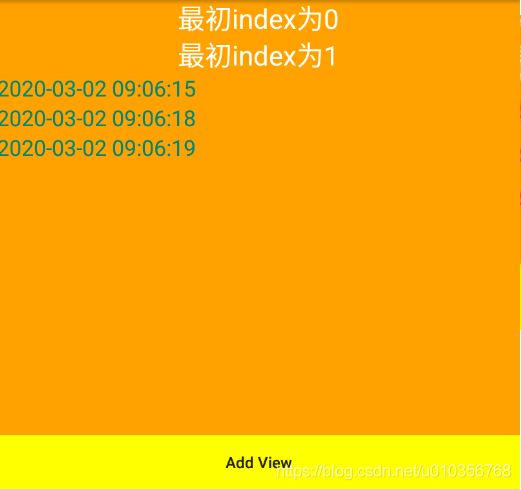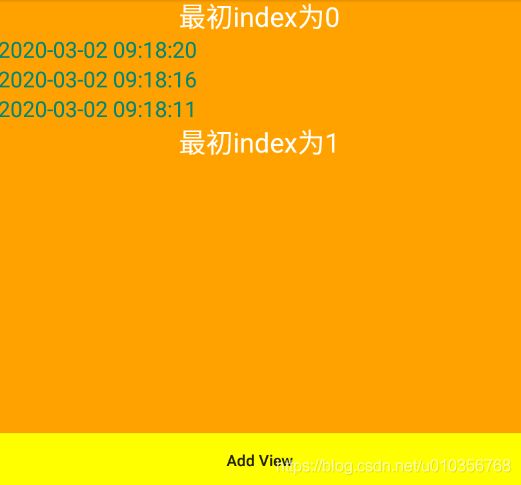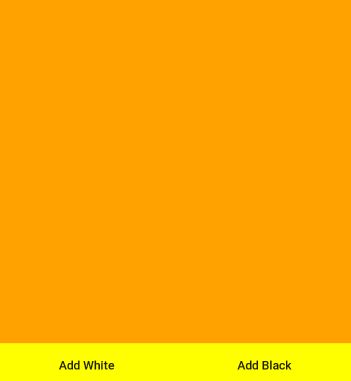Android动态添加View
文章目录
- addView的使用
- 在LinearLayout中的使用
- addView(View child)
- addView(View child, int index)
- 小结
- 在RelativeLayout中的使用
- index在RelativeLayout中有用吗?
动态添加View我们就要通过addView的方式动态向布局中添加View。(ps:addView是ViewGroup中特有的方法,而单一的View是不存在该方法的)
addView的使用
addView(View child) // child-被添加的View
addView(View child, int index) // index-被添加的View的索引
addView(View child, int width, int height) // width,height被添加的View指定的宽高
addView(View view, ViewGroup.LayoutParams params) // params被添加的View指定的布局参数
addView(View child, int index, LayoutParams params)
在LinearLayout中的使用
addView(View child)
LinearLayout中View的排列是按照指定的方向上线性排列的,子View的索引也是从零开始按照排列的顺序依次递增的
1.首先新建一个Activity并在布局中指定一个LinearLayout作为容器。布局文件如下:
<?xml version="1.0" encoding="utf-8"?>
<LinearLayout xmlns:android="http://schemas.android.com/apk/res/android"
android:layout_width="match_parent"
android:layout_height="match_parent"
android:orientation="vertical">
<!--添加view的容器-->
<LinearLayout
android:id="@+id/container"
android:layout_width="match_parent"
android:layout_height="400dp"
android:background="#ffa200"
android:orientation="vertical">
<!--事先存在的view-->
<TextView
android:layout_width="wrap_content"
android:layout_height="wrap_content"
android:layout_gravity="center_horizontal"
android:text="最初index为0"
android:textColor="#ffffff"
android:textSize="25sp" />
<!--事先存在的view-->
<TextView
android:layout_width="wrap_content"
android:layout_height="wrap_content"
android:layout_gravity="center_horizontal"
android:text="最初index为1"
android:textColor="#ffffff"
android:textSize="25sp" />
</LinearLayout>
<!--点击按钮添加view-->
<Button
android:id="@+id/btn_add"
android:layout_width="match_parent"
android:layout_height="50dp"
android:background="#ffff00"
android:text="Add View"
android:textAllCaps="false" />
</LinearLayout>
原始布局如下:

2.现在我们编写Activity的代码,对控件进行初始化以及点击事件的设置,如下所示:
public class MainActivity extends AppCompatActivity {
private LinearLayout mContainer;
private Button btn_add;
@Override
protected void onCreate(Bundle savedInstanceState) {
super.onCreate(savedInstanceState);
setContentView(R.layout.activity_main);
mContainer = findViewById(R.id.container);
btn_add = findViewById(R.id.btn_add);
btn_add.setOnClickListener(new View.OnClickListener() {
@Override
public void onClick(View view) {
addView(view);
}
});
}
private void addView(View view){
TextView textView = new TextView(this);
textView.setTextColor(getResources().getColor(R.color.colorPrimary));
textView.setTextSize(20);
textView.setText(date(System.currentTimeMillis()));
mContainer.addView(textView);
}
private String date(long time){
SimpleDateFormat sdf = new SimpleDateFormat("yyyy-MM-dd HH:mm:ss");
Date date = new Date(time);
return sdf.format(date);
}
}
点击按钮后效果

由上述效果图我们可以初步分析得出结论,在线性布局中,我们调用addView(View child)方法时,会在指定的方向的最后一个View的下面添加上child这个View,也就是说被添加的View的索引总是等于容器中当前子View的个数
addView(View child, int index)
此方法相对于上面的方法多了一个index参数,也就是调用此方法时我们会给被添加的View指定一个索引。下面,我们来修改addView方法的代码,addView时,指定索引为1
mContainer.addView(textView,1);
点击按钮效果图

当我们为添加的View指定了index后,我们被添加的View就会被添加到容器中指定的索引位置处,并把之前的View(包括此View后面的View)全部向后“挤”了一位
当然,在我们指定索引时,我们应当先做一个判断,确保我们指定的index不能大于当前容器内View的总数量。代码可以如下
int index = new Random().nextInt();
if (index > mContainer.getChildCount()) { // 当index大于当前容器子View数量时,让他等于容器内子View的数量。
index = mContainer.getChildCount();
}
mContainer.addView(child, index);
小结
LinearLayout中addView的使用就只介绍这两种方法,这里指定线性布局的排列方向为垂直方向,当然指定为水平方向也是一样的效果,只是在添加View的方向上变为了水平方向的改变。在这里讲解调用这两个参数的方法主要是因为在LinearLayout中能更好的理解一些
在RelativeLayout中的使用
1.布局文件:
首先修改布局文件,这里将最初顶部的容器改为一个空的RelativeLayout。底下的按钮变成了两个,分别用于添加颜色不同的View。布局代码就不粘贴了,看一下改完的初始效果图:

private void addViewWhite(View view){
TextView textView = new TextView(this);
textView.setTextColor(Color.WHITE);
textView.setTextSize(20);
textView.setText("LayoutParams");
mContainer.addView(textView);
}
private void addViewBlack(View view){
TextView textView = new TextView(this);
textView.setTextColor(Color.BLACK);
textView.setTextSize(20);
textView.setText("LayoutParams");
//定义LayoutParam
RelativeLayout.LayoutParams layoutParams = new RelativeLayout.LayoutParams(ViewGroup.LayoutParams.WRAP_CONTENT,ViewGroup.LayoutParams.WRAP_CONTENT);
layoutParams.leftMargin = 100;
mContainer.addView(textView,layoutParams);
}
LayoutParams理解和使用
index在RelativeLayout中有用吗?
添加黑色View代码改为
mContainer.addView(textView,0,layoutParams);
看下运行效果

可以认为index指定了View在里面的层级。一个View的index越大,说明它越在上面。这一点在FrameLayout中是一样的(注意,如果在使用addView时候想设置index,也要遵循上面说到的规则)
原文
